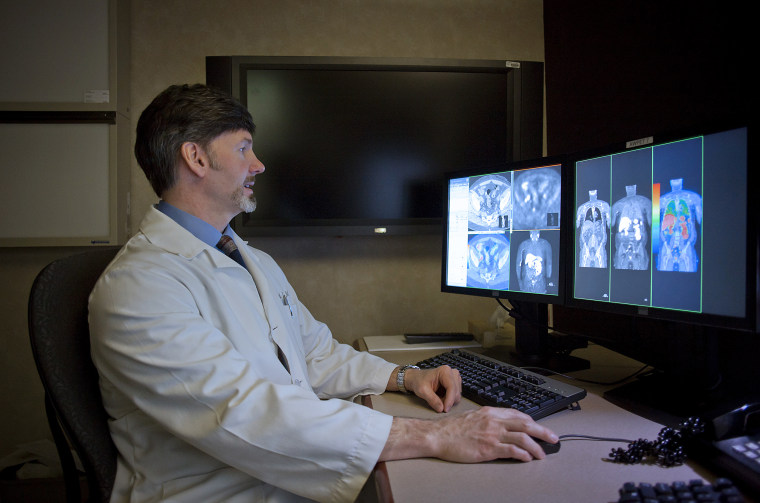Cases of aggressive prostate cancer appear to be on the rise, researchers reported Tuesday.
The good news is it’s still rare for prostate cancer to spread. Just 3 percent of cases have already started spreading when men are diagnosed and prostate cancer overall has not become more common, the team found.
And the American Cancer Society strongly questioned the findings and the methods used to get them.
The researchers -- who were looking for evidence to support a return to widespread prostate cancer screening -- found that cases of metastatic prostate cancer — the type that has started to spread in the body — nearly doubled in men aged 55 to 69 since 2004. The reason is not yet clear.
“One hypothesis is the disease has become more aggressive, regardless of the change in screening,” said Dr. Edward Schaeffer, chair of urology at Northwestern University Feinberg School of Medicine and Northwestern Medicine, who led the study.
“The other idea is since screening guidelines have become more lax, when men do get diagnosed, it’s at a more advanced stage of disease. Probably both are true. We don’t know for sure, but this is the focus of our current work,” Schaeffer continued.
“One hypothesis is the disease has become more aggressive, regardless of the change in screening."
In 2012, the U.S. Preventive Services Task Force (USPSTF) recommended against using a blood test called a prostate-specific antigen (PSA) test to check most healthy men for prostate cancer.
“You should know what the science says about PSA screening: There is a small potential benefit and there are significant potential harms,” the USPSTF says.
It said the test found very few men with prostate cancer that needed treatment, and caused men to be needlessly treated for slow-growing prostate tumors that never would have harmed them. Sometimes that treatment meant side effects, from impotence to incontinence.
The American Cancer Society supports this cautious approach to screening and questioned Schaeffer's study.
“This study makes a dramatic claim about an issue all of us have been watching eagerly: namely, whether less PSA screening might lead to more advanced cancers. But the current analysis is far from adequate to answer that question sufficiently," the group's chief medical officer, Dr. Otis Brawley, said in a statement.
“Epidemiologists learned long ago that you can’t simply look at raw numbers. A rising number of cases can be due simply to a growing and aging population among other factors," Brawley added.
"In addition, in this study, the rise they detected began before USPSTF guidelines for screening changed. There may or may not be a rise in the rates of metastatic disease; but because of a flawed analysis, this study does not answer that important question."
Related: Some Men Say No to Prostate Screening
Schaeffer is a strong advocate of screening and is critical of newer recommendations that men don’t usually need regular prostate cancer screening. He and his colleagues set out to see if the recommendation had caused more men to end up with advanced prostate cancer by the time they got diagnosed.
They looked at the medical records of 767,550 treated between 2004 and 2013 at 1,089 hospitals and clinics from the National Cancer Data Base.
“Of the 767,550 men with prostate cancer included in our study, 3 percent had metastases at diagnosis,” the team wrote in the journal Prostate Cancer and Prostatic Diseases.
"Relative to 2004, the annual incidence of all prostate cancer did not change significantly over time.”
“The remainder had localized disease: 32 percent low, 45 percent intermediate and 20 percent high risk,” they added.
"Relative to 2004, the annual incidence of all prostate cancer did not change significantly over time.”
Related: Cancer Deaths Fall
But metastatic prostate cancer — the kind that has spread — became more common, while slow-growing tumors became less common, they found
“The largest increase in metastatic prostate cancer was seen among the age group (55–69 years) thought to benefit most from prostate cancer screening and early definitive treatment,” Schaeffer’s team wrote.
They admitted that the drop in PSA screening did not seem to be to blame.
“These findings cannot be explained completely by reactions to the USPSTF recommendations alone, as increases in metastatic prostate cancer began in the years before its release,” they wrote.
"We urgently need smarter and more targeted cancer screening, so we don't leave men at highest cancer risk unprotected."
“The fact that men in 2013 who presented with metastatic disease had much higher PSAs than similar men in 2004 hints that more aggressive disease is on the rise,” Schaeffer said in a statement.
“If I were a patient, I would want to be vigilant. I firmly believe that PSA screening and rectal exams save lives.”
Related: Average U.S. Diet May Kill Prostate Cancer Patients
Prostate cancer is very common, showing up in 240,000 U.S. men every year. It kills about 30,000 a year.
Once cancer has begun to spread in the body, it usually cannot be cured.
“Prostate cancer is 100 percent treatable if detected early, but some men are more likely to develop aggressive disease that will recur, progress and metastasize," said Dr. Jonathan Simons, president and CEO of the Prostate Cancer Foundation.
"Not all men with prostate cancer need immediate surgery or radiation. But every case needs precision prostate cancer care," Simons added. "We urgently need smarter and more targeted cancer screening, so we don't leave men at highest cancer risk unprotected from early, curable disease being missed and turning into incurable disease."

